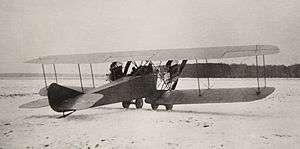AEG G.I
| AEG K.I and G.I | |
|---|---|
 | |
| Role | Bomber |
| National origin | Germany |
| Manufacturer | AEG |
| First flight | early 1915 |
| Introduction | 1915 |
| Primary user | Luftstreitkräfte |
| Number built | 1 |
| Developed into | AEG G.II |
The AEG G.I (originally designated as the K.I) was a three-seat, twin-engined German biplane bomber aircraft of World War I. It was tested and found to be viable for air-fighting in the latter half of 1915[1] but performed poorly, necessitating the development of the AEG G.II.
Specifications (AEG G.I)
Data from German Aircraft of the First World War [2]
General characteristics
- Crew: three
- Length: 8.65 m (28 ft 4 in)
- Wingspan: 16.00 m (52 ft 6 in)
- Height: 3.46 m (11 ft 4 in)
- Wing area: 59 m² (635 ft²)
- Empty weight: 1,160 kg (2,558 lb)
- Max. takeoff weight: 1,960 kg (4,322 lb)
- Powerplant: 2 × Mercedes D.I six-cylinder water cooled inline engine, 74.5 kW (100 hp) each
Performance
- Maximum speed: 125 km/h (78 mph)
- Range: 450 km (281 mi)
- Service ceiling: 2,400 m (7,874 ft)
Armament
- Guns: 2 × 7.92 mm (.312 in) machine guns
- Bombs: 200 kg (440 lb) of bombs
See also
- Related development
- Aircraft of comparable role, configuration and era
References
| Wikimedia Commons has media related to AEG aircraft. |
- Notes
- Bibliography
- Gray, Peter and Thetford, Owen. German Aircraft of the First World War. London:Putnam, 1970 2nd. Ed..
This article is issued from Wikipedia - version of the 4/4/2016. The text is available under the Creative Commons Attribution/Share Alike but additional terms may apply for the media files.